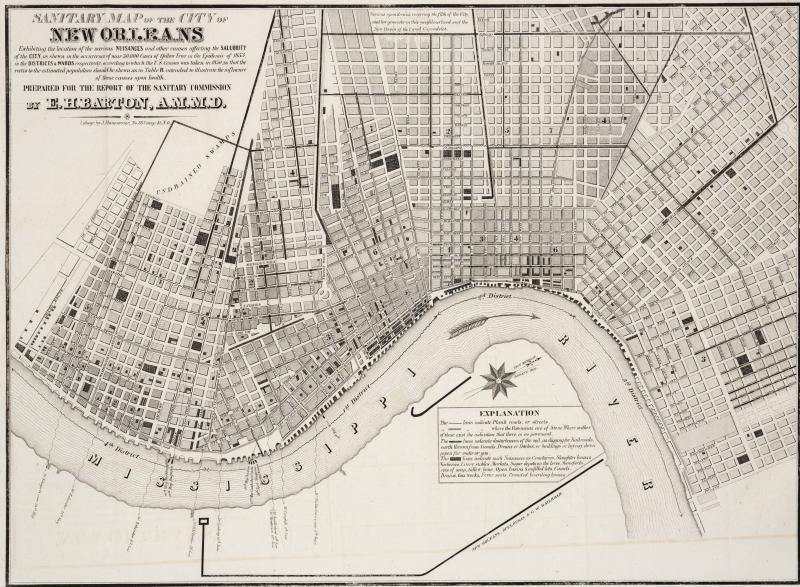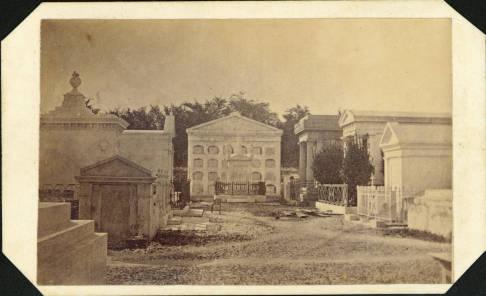
The spread of yellow fever was a result of complex ecological and demographic changes produced by the development of both plantations and metropolitan centers.

By Dr. Urmi Engineer Willoughby
Assistant Professor of History
Murray State University
In the early decades of the nineteenth century, yellow fever epidemics occurred with increased frequency in New Orleans in the late summer. The yellow fever virus is of West African origin, and carried by mosquitoes (Aedes aegypti) that are indigenous to tropical Africa. While temperate port cities along the Atlantic seaboard suffered from numerous epidemics in the eighteenth century, New Orleans remained free from yellow fever. The city experienced its first epidemic in 1796, and epidemics occurred frequently after 1817. New Orleans and the Gulf Coast developed into an ecological zone of seasonally endemic yellow fever as a result of changes tied to the area’s growth as both a sugar-producing slave society and urban port in the nineteenth century.
The rise of yellow fever in New Orleans was not an inevitable consequence of the Atlantic slave trade. Atlantic vessels certainly introduced African pathogens and mosquitoes to the Americas, but the prevalence of A. aegypti and the spread of yellow fever were a result of complex ecological and demographic changes produced by the development of both plantations and metropolitan centers.
Environmental changes fostered the growth of A. aegypti populations. This species has evolved to flourish in domesticated spaces, showing a preference for breeding in manmade receptacles and living alongside humans. The connection between large-scale sugar plantations and A. aegypti is a pattern that emerged across the Greater Caribbean. In Louisiana, sugar cultivation required extensive landscape alterations, including heavy deforestation and the construction of drainage ditches and canals, which opened a niche for mosquitoes. Additionally, plantations formed a sustainable breeding environment due to the abundance of cisterns, water-barrels, and clay pots, which collected fresh water where mosquitoes could lay eggs. Sugar plantations also provided nourishment for mosquitoes, in the form of sucrose. In New Orleans, the simultaneous growth of plantations and urban infrastructure transformed the landscape in ways that further enabled the propagation of A. aegypti. Water management projects, including swamp drainage and canal construction, alongside urban development, created new breeding places.

The first documented outbreak of yellow fever in New Orleans occurred in the summer of 1796, a few years after a series of severe epidemics in the 1790s in Philadelphia and New York. In New Orleans, epidemics began just after the city began producing and exporting sugar, and coincided with a major canal-building project that aimed to connect the French “Old City” (or Vieux Carré) to Lake Pontchartrain and Bayou St. John. Observers commonly noticed the presence of fevers during periods of digging, and the high mortality among canal construction laborers. Succeeding epidemics, in 1811, 1817, 1819, and 1822, all coincided with canal repair work.

Yellow fever epidemics occurred with more frequency after 1817, as the disease spread to regions connected to the port of New Orleans by rivers and canals. In the 1830s and 1840s, the construction of short rail lines connected the city to surrounding parishes, and by the 1850s, several long-distance lines linked New Orleans to urban centers in Tennessee, Mississippi, and Texas. The expansion of Louisiana’s sugar industry in the 1820s through the 1850s rapidly transformed New Orleans into an active entrepôt due to increased port traffic, which intensified due to new steam-powered technologies. These changes generated rapid demographic growth during this period, as newcomers arrived from the eastern United States and Europe.

Alongside the construction of artificial levees and canals, the city expanded and built residential and commercial districts by draining the land around the Vieux Carré. Suburban development created additional places for A. aegypti to breed, in structures such as architectural ornamentation that adorned gardens and cemeteries. The physical expansion of New Orleans prompted the construction of short rail lines, which further supported the growth of New Orleans as center of trade. Ecological changes resulting from railroad construction facilitated yellow fever epidemics, and completed lines enabled the virus to spread from the city to nearby plantations and towns. Like laborers who built canals, immigrants who worked in railroad construction were especially likely to contract yellow fever, and suffered disproportionately high mortality rates during epidemics.

Alterations to the landscape, combined with demographic changes resulting from the rise of sugar production, slavery, and urban growth all contributed to the region’s development as a yellow fever zone. From 1796 through about 1820, most newcomers came from the Caribbean and were likely to have encountered yellow fever prior to their arrival in New Orleans. Demographic patterns substantially changed after 1815, due to the United States’ purchase of the Louisiana territory in 1803 and the establishment of the state of Louisiana and capital in New Orleans in 1812. Though the 1820s and 1830s, tens of thousands migrants from the eastern United States settled in the region, including white planters and enslaved African Americans. In the 1840s and 50s, an increasing number of Irish, German, and other European immigrants settled in the city. Epidemics escalated, and affected a high proportion of newcomers. Demographic changes increased the likelihood of epidemics, as American and European migrants provided a sizable population of non-immune individuals to host the disease. In the summer of 1853, New Orleans experienced its most devastating epidemic of the antebellum era, which killed nearly 15 percent of the city’s population.

The warm, wet landscape of New Orleans was not sufficient to engender the promulgation of A. aegypti, and epidemics were by no means a natural disaster. Changes to the landscape and human migrations allowed the mosquito and the virus to thrive in the growing metropolis.
Further Reading
- Campanella, Richard. Geographies of New Orleans: Urban Fabrics before the Storm. Lafayette: Center for Louisiana Studies at the University of Southwestern Louisiana, 2006.
- Colten, Craig E. Southern Waters: The Limits to Abundance. Baton Rouge: Louisiana State University Press, 2014.
- Dessens, Nathalie. Creole City: A Chronicle of Early American New Orleans. Gainesville: University Press of Florida, 2015.
- Goodyear, James D. “The Sugar Connection: A New Perspective on the History of Yellow Fever.” Bulletin of the History of Medicine 52 (1978): 5–21.
- Kelman, Ari. A River and Its City: The Nature of Landscape in New Orleans. Berkeley: University of California Press, 2003.
- McNeill, J. R. Mosquito Empires: Ecology and War in the Greater Caribbean, 1620–1914. Cambridge: Cambridge University Press, 2010.
- Trask, Benjamin H. Fearful Ravages: Yellow Fever in New Orleans, 1796–1905. Lafayette: Center for Louisiana Studies, 2005.
Originally published by Arcadia: Explorations in Environmental History, 5 (Autumn 2017), under a Creative Commons Attribution 4.0 International license.







